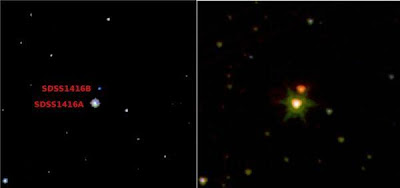 Un equipo internacional, liderado por astrónomos de la Universidad de Hertfordshire y utilizando el UKIRT (United Kingdom Infrared Telescope) en Hawai, ha encontrado lo que podría ser el objeto sub-estelar más frío de fuera de nuestro sistema solar: una enana marrón.
Un equipo internacional, liderado por astrónomos de la Universidad de Hertfordshire y utilizando el UKIRT (United Kingdom Infrared Telescope) en Hawai, ha encontrado lo que podría ser el objeto sub-estelar más frío de fuera de nuestro sistema solar: una enana marrón.Demasiado pequeñas para ser estrellas, las enanas marrones tienen masa menor que la de una estrella, pero mayor que la de los planetas gigantes gaseosos como Júpiter. Debido a su baja temperautra, estos objetos son muy tenues a la luz visible y solo pueden detectarse por su brillo a longitudes de onda infrarrojas. Se las apodó como enanas marrones mucho antes de que se las descubriera, para referirse a cuerpos que fueran más fríos, más tenues y más rojizos que las enanas rojas, con el color marrón como mezcla de rojo y negro.
El objeto es conocido como SDSS1416+13B y orbita alrededor de una enana marrón algo más brillante y caliente conocida como SDSS1416+13A. El miembro más brillante de la pareja fue detectado en el espectro visible por el Sloan Digital Sky Survey. Por el contrario,S DSS1416+13B solo es visible en el infrarrojo. La pareja está a una distancia entre 15 y 50 años-luz del sistema solar, o sea muy cerca en términos astronómicos.
Según el Dr Philip Lucas de la School of Physics, Astronomy and Mathematics de la Universidad de Hertfordshire, "es la cuarta vez en tres años que el UKIRT ha alcanzado un nuevo record al descubrir la enana marrón más fría, con una temperatura estimada no muy superior a los 200ºC".
"Tenemos que ser cuidadosos sobre ello, porque sus colores son tan diferentes de cualquier cosa vista hasta ahora, que en realidad no lo entendemos todavía. Incluso aunque resultara que la temperatura no fuera un record, los colores son tan extremos que este objeto mantendrá ocupados a un montón de físicos intentando explicarlo"
 An international team, led by astronomers at the University of Hertfordshire Using the United Kingdom Infrared Telescope (UKIRT) in Hawai, has found what may be the coolest sub-stellar body ever found outside our own solar system: a brown dwarf.
An international team, led by astronomers at the University of Hertfordshire Using the United Kingdom Infrared Telescope (UKIRT) in Hawai, has found what may be the coolest sub-stellar body ever found outside our own solar system: a brown dwarf.Too small to be stars, brown dwarfs have masses smaller than stars but larger than gas giant planets like Jupiter. Due to their low temperature these objects are very faint in visible light, and are detected by their glow at infrared wavelengths. They were originally dubbed "brown dwarfs" long before any were actually discovered, to describe the idea of bodies that were cooler, fainter and redder than red dwarf stars, with the colour brown representing the mix of red and black.
The object is known as SDSS1416+13B and it is in a wide orbit around a somewhat brighter and warmer brown dwarf, SDSS1416+13A. The brighter member of the pair was detected in visible light by the Sloan Digital Sky Survey. By contrast, SDSS1416+13B is only seen in infrared light. The pair is located between 15 and 50 light years from the solar system, which is quite close in astronomical terms.
"This looks like being the fourth time in three years that the UKIRT has discovered made a record breaking discovery of the coolest known brown dwarf, with an estimated temperature not far above 200 degrees Celsius," said Dr Philip Lucas at the University of Hertfordshire's School of Physics, Astronomy and Mathematics.
"We have to be a bit careful about this one because its colours are so different than anything seen before that we don't really understand it yet. Even if it turns out that the low temperature is not quite record breaking, the colours are so extreme that this object will keep a lot of physicists busy trying to explain it."
No hay comentarios:
Publicar un comentario